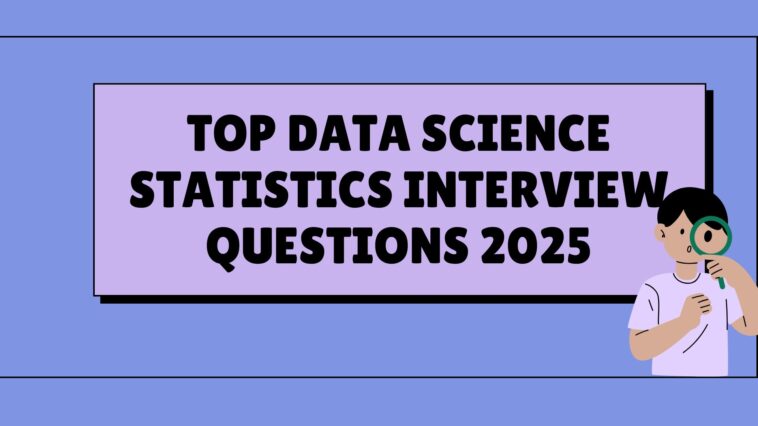Statistics form the backbone of data science. From building predictive models to making data-driven decisions, a strong grasp of statistical concepts is essential. In 2025, as data science roles become more specialized, employers are increasingly focusing on candidates who can demonstrate a clear understanding of statistics.
To help you prepare, here’s a curated list of the top statistics interview questions for data science roles in 2025, along with simple explanations to guide your preparation.
1. What is the difference between descriptive and inferential statistics?
Descriptive statistics summarize and describe the features of a dataset, such as mean, median, mode, and standard deviation. Inferential statistics, on the other hand, use a random sample of data to make inferences or predictions about a larger population. Understanding this distinction is fundamental in data analysis.
2. Explain the concept of p-value.
The p-value is a measure that helps determine the significance of results in hypothesis testing. It indicates the probability of obtaining results at least as extreme as the observed results, assuming the null hypothesis is true. A low p-value (typically ≤ 0.05) suggests that the null hypothesis can be rejected.
3. What is a confidence interval?
A confidence interval is a range of values, derived from a dataset, that is likely to contain the true population parameter. It is expressed with a confidence level, such as 95%, indicating that if the same population were sampled multiple times, 95% of the calculated intervals would contain the true parameter.
4. Describe the Central Limit Theorem.
The Central Limit Theorem (CLT) states that the distribution of the sample means will approach a normal distribution as the sample size increases, regardless of the original population distribution, provided the samples are independent and identically distributed. This theorem is crucial for making inferences about population parameters.
5. What is the difference between Type I and Type II errors?
A Type I error occurs when the null hypothesis is incorrectly rejected (false positive), while a Type II error happens when the null hypothesis is not rejected when it is false (false negative). Understanding these errors is vital for evaluating the reliability of statistical tests.
6. What is the purpose of regression analysis?
Regression analysis is used to understand the relationship between dependent and independent variables. It helps in predicting the value of a dependent variable based on the values of one or more independent variables. Common types include linear regression, logistic regression, and polynomial regression.
7. Explain the concept of correlation and how it differs from causation.
Correlation measures the strength and direction of a linear relationship between two variables, typically quantified by the correlation coefficient (r). However, correlation does not imply causation; just because two variables are correlated does not mean one causes the other.
8. What are outliers, and how do you handle them?
Outliers are data points that differ significantly from other observations. They can skew results and affect statistical analyses. Handling outliers can involve removing them, transforming data, or using robust statistical methods that are less sensitive to outliers.
9. What is the difference between a population and a sample?
A population includes all members of a specified group, while a sample is a subset of the population used to represent the whole. Sampling is essential in statistics to make inferences about a population without needing to collect data from every member.
10. What is the significance of the normal distribution in statistics?
The normal distribution is a probability distribution that is symmetric about the mean, showing that data near the mean are more frequent in occurrence than data far from the mean. Many statistical tests assume normality, making it a foundational concept in statistics.
11. How do you interpret a confusion matrix?
A confusion matrix is a table used to evaluate the performance of a classification model. It summarizes the true positives, true negatives, false positives, and false negatives, allowing you to calculate metrics like accuracy, precision, recall, and F1 score.
12. What is the purpose of hypothesis testing?
Hypothesis testing is a statistical method used to make decisions about a population based on sample data. It involves formulating a null hypothesis and an alternative hypothesis, then using statistical tests to determine which hypothesis is supported by the data.
13. Explain the concept of statistical power.
Statistical power is the probability that a statistical test will correctly reject a false null hypothesis (i.e., avoid a Type II error). Higher power is desirable and can be achieved by increasing sample size, effect size, or significance level.
14. What is multicollinearity, and why is it a problem?
Multicollinearity occurs when two or more independent variables in a regression model are highly correlated, making it difficult to determine the individual effect of each variable. It can lead to unreliable coefficient estimates and inflated standard errors.
15. Describe the difference between parametric and non-parametric tests.
Parametric tests assume that the data follows a certain distribution (usually normal), while non-parametric tests do not make such assumptions. Non-parametric tests are often used when data does not meet the assumptions required for parametric tests.
16. What is the role of ANOVA in statistics?
ANOVA (Analysis of Variance) is a statistical method used to compare means among three or more groups to determine if at least one group mean is significantly different from the others. It helps in understanding the impact of categorical independent variables on a continuous dependent variable.
17. How do you assess the goodness of fit for a model?
The goodness of fit can be assessed using various metrics, such as R-squared, adjusted R-squared, and residual plots. These metrics help determine how well the model explains the variability of the data.
18. What is the difference between a one-tailed and a two-tailed test?
A one-tailed test tests for the possibility of the relationship in one direction, while a two-tailed test tests for the possibility in both directions. The choice between them depends on the research hypothesis.
Final Thoughts
Preparing for data science interviews in 2025 requires a strong grasp of statistical concepts and their real-world applications. By familiarizing yourself with common statistics interview questions, you’ll not only strengthen your understanding but also improve your ability to communicate insights, an essential skill for showcasing your analytical abilities to potential employers. Whether you’re studying on your own or enhancing your expertise through a leading best data science course in Noida, Delhi, or Faridabad, regularly practicing these concepts will boost both your confidence and clarity during interviews.
This post was created with our nice and easy submission form. Create your post!




